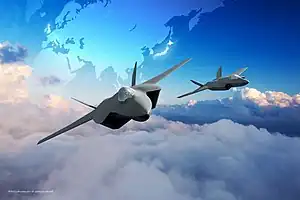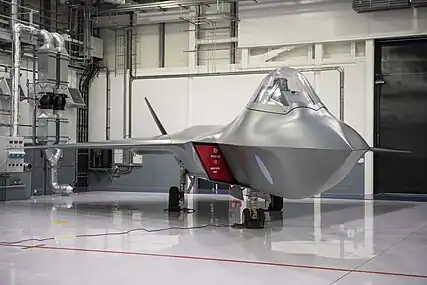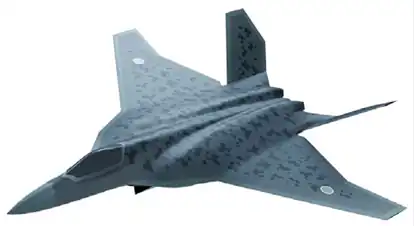| Global Combat Air Programme (GCAP) | |
|---|---|
 | |
| General information | |
| Project for | Multirole fighter |
| Issued by | Royal Air Force Japan Air Self-Defense Force Italian Air Force |
| History | |
| Initiated | December 2022 |
| Predecessors | BAE Systems Tempest, Mitsubishi F-X |
The Global Combat Air Programme (GCAP) is a multinational initiative led by the United Kingdom, Japan, and Italy to jointly develop a sixth-generation stealth fighter. The programme aims to replace the Eurofighter Typhoon in service with both the Royal Air Force (RAF) and the Italian Air Force, and the Mitsubishi F-2 in service with the Japan Air Self-Defense Force.
On 9 December 2022, the governments of Japan, the United Kingdom, and Italy jointly announced that they would develop and deploy a common fighter jet, merging their previously separate sixth-generation projects: the United Kingdom-led BAE Systems Tempest developed with Italy, and the Japanese Mitsubishi F-X.[1][2] This was cemented with a treaty signed in December 2023 in Japan.[3]
Under the current timeline, the program expects to begin the formal development phase from 2025, with a demonstrator to fly in 2027, and production aircraft to begin entering service from 2035.[4]
Background
United Kingdom & Italy (Tempest)
On 16 July 2018 during the Farnborough Airshow, then UK defence secretary Gavin Williamson publicly revealed a mock-up of 'Tempest' a BAE Systems led sixth-generation fighter program and wider Future Combat Air System (FCAS) that would be developed to replace the RAF's Eurofighter Typhoons in the mid-to-late 2030s.[5][6] A year later on 19 July 2019, Sweden signed a Memorandum of understanding (MoU) with the UK to work together in developing the wider FCAS needed for the future of aerial operations.[7] on 11 September during DSEI 2019, Italy formally joined the Tempest program.[8][9] In 2020, Sweden and the UK 'firmed up' their MoU for FCAS and saw Sweden's SAAB establish a centre-of-excellence in the UK as part of a £50 million investment, However it was stressed that this was not an indication that Sweden or SAAB had signed onto the main Tempest effort.[10] On the 21 December 2021, The UK, Italy, and Sweden signed a trilateral MoU for cooperation on the FCAS.[11]

A number of new technologies were being explored for possible deployment on Tempest, including:[12][13]
- Directed-energy weapons
- Augmented reality cockpit - control scheme featuring little-to-no physical controls, instead displaying features virtually on the heads up display via the pilot's helmet. This would reduce aircraft weight, improve upgradability through a software-based approach, and provide additional display space for information outside of the typical flat-screen arrangement. This also includes examinations into interactivity such as motion-control and eye-tracking.
- Biometric and psycho-analytical monitoring - exploring pilot health monitoring during combat and training to identify issues such as stress, confusion, cognitive load, as well as hypoxia or G-lock.
- Manned-unmanned teaming - crewed aircraft like Tempest working cooperatively with uncrewed aerial vehicles (UAVs) known as 'Adjuncts' (also known as Loyal Wingmen or Remote Weapon Carriers in other aircraft programs)
- Artificial intelligence (AI) - known as the Intelligent Virtual Assistant (IVA) that could assist with aircraft operations or data processing in certain operations or situations.
It was envisaged that the program would agree to funding and manufacturing arrangements in 2025 with an expected in-service date for the aircraft in 2035.[12]
Japan (F-X)

Following the USA's decision not to allow the export of the F-22 Raptor, Japan began looking for a domestic solution to field a new fighter aircraft. From the mid-2000s Japan began funding various research programs involved in fighter design culminating in the Mitsubishi X-2 Shinshin experimental aircraft which took flight on 22 April 2016. This research and the data collected from the X-2 program would feed the development of Japan's main fighter effort, the Mitsubishi F-X program.
Early cooperation
Discussions to combine efforts on both fighter projects as a means of reducing overall development costs began as early as 2017.[14][15][16] This began yielding results in December 2021 when the UK and Japan announced they would jointly cooperate to produce a demonstrator for a new fighter engine as well as the signing of a memorandum of cooperation to explore future air combat technologies together.[17] On 15 February 2022, a further agreement was reached between both nations to jointly develop sensor capabilities for their respective fighters known as the 'Japan and Great Britain Universal Advanced RF (radio-frequency) system' or 'JAGUAR'.[18][19]
Development
Program initialisation
In July 2022, Reuters reported from anonymous sources within both programs that both parties were close to a deal for merging Tempest and F-X into a single program.[20] In December 2022, this was proven correct when the final decision was made to merge the development of both programs into a single endeavour to procure a common multi-role fighter now called the "Global Combat Air Program" (GCAP).[21][22][2] The resulting aircraft is also expected to be available for the export market to further reduce the per-unit costs.[23]
The programme is envisaged as an equal partnership between the member nations. In the UK, BAE Systems will act as prime contractor and handle the airframe, Rolls-Royce the engines, Leonardo's UK division the electronics, and MBDA UK the weapons. In Japan, Mitsubishi Heavy Industries will act as prime contractor, with IHI Corporation handling the engines, and Mitsubishi Electric handling the electronics. In Italy, Leonardo S.p.A. will be prime contractor, with Avio Aero working on the engines, and MBDA IT will also work on missile development.[24]
By around 2024, detailed development and cost sharing for each company will be clarified, and production will begin around 2030, with the first aircraft to be deployed in 2035.[24]
Possible Swedish, Saudi Arabian, and German membership
In late December 2022, two weeks after GCAP was announced, Japan and Sweden signed an ‘Agreement on the Transfer of Defense Equipment and Technology' that would explore deeper bilateral ties between both nations.[25] This also began speculation as to Sweden potentially becoming a member of GCAP as a means of replacing their Saab JAS 39 Gripen given that Sweden had previously been cooperating with the UK and Italy regarding the FCAS to which Tempest would have contributed.[11][25] However, in March 2023, several industrial figures involved in GCAP placed doubt on Sweden joining GCAP with some stating that Sweden's concepts for FCAS did not align with the views of the UK or Italy.[26]
On 11 August 2023, the Financial Times reported that that Saudi Arabia was pushing to join the program.[27] While the UK and Italy were reportedly open to the concept, Japan was firmly opposed, seeing Saudi membership as a complication to both further domestic efforts in allowing Japanese defence exports to foreign nations and the overall timeline for the program in successfully producing an in-service aircraft by 2035.[27][28] There were also concerns from defence sources that the security of sensitive technology might be complicated by Saudi membership as well as the questionable technical contribution that the Kingdom could feasibly provide to GCAP.[27]
On 15 September, Leonardo's CEO said that Saudi Arabia would not become a core partner in GCAP, with Reuters reporting that in a response to the question of Saudi membership they said "The programme is (for) UK, Japan, Italy, that's it. There is nothing else at the moment".[29][30]
On 1 November 2023, The Times reported on leaked rumours that Germany was considering abandoning the €100 billion Future Combat Air System; also known by its French designation SCAF (a parallel European effort to field a sixth-generation fighter design alongside other systems) with other core members France and Spain, and would instead look to join GCAP.[31] Extensively this was due to ongoing problems within both the SCAF program regarding intellectual property and industrial participation as well as tensions spilling over from other European programs such as on matters of air defence and Germany's procurement of the F-35A. However, many experts were quick to point out that the complexity of the discussions for this type of program should keep observers sceptical of such rumours. James Black from Rand Europe and Isabella Antinozzi from RUSI explained to Shepard News that this leak might potentially be a German negotiating tactic to pressure France and Spain to concede into more of Germany's demands for the program or risk their divergence. There was also scepticism as to whether Germany would even be able to join GCAP, at least to the same level of membership they had within SCAF, especially given previous statements by GCAP industry heads.[32][29][30]
In December 2023, a Swedish official during the International Fighter Conference announced that Sweden would not make a decision on a future fighter to replace the Gripen until 2031 following several national studies and related planning efforts.[33][34] It was also mentioned that Sweden walked away from bilateral and trilateral discussions with the UK and Italy a year before, but did not expand on the reasons for this decision. Whilst such a decision does not rule-out future Swedish participation in GCAP, delaying membership in the program would risk losing industrial influence over design requirements.[26]
Collaboration and treaty signing
On the first day of DSEI 2023 on 12 September, a trilateral collaboration agreement was signed between all three parties to support the long-term working arrangements and capability requirements of the program.[35]
On 14 December 2023, 12 months after the initial agreement to pursue GCAP, the tri-lateral effort was cemented with the signing of an international treaty for the development of the aircraft in Tokyo.[3][36] This treaty would see both the collaborative governmental headquarters and industrial hub for the effort based in the UK, confirming earlier reports, with Japan providing the first CEO and Italy the first leader of the business entity.[29][3][36]
Similar programs
- Next Generation Air Dominance (NGAD) - US Air Force's sixth-generation fighter program
- F/A-XX - US Navy's sixth-generation fighter program
- Future Combat Air System (FCAS / SCAF) - European (French / German / Spanish / Belgian) sixth-generation fighter program
See also
References
- ↑ Kosuke, Takahashi (9 December 2022). "Why Japan Chose Britain and Italy for Its F-X Fighter Program". The Diplomat. Archived from the original on 7 November 2023.
- 1 2 Chuter, Andrew (9 December 2022). "Move over, Tempest: Japan pact takes UK-Italy fighter plan 'global'". Defense News. Archived from the original on 11 December 2022. Retrieved 11 December 2022.
- 1 2 3 Neumann, Norbert (14 December 2023). "GCAP alliance signs treaty for sixth-generation fighter and establishes UK as programme HQ". Shephard Media. Archived from the original on 1 January 2024. Retrieved 15 December 2023.
- ↑ Hemler, Jon (14 June 2023). "BRIEFER: Global Combat Air Program (GCAP)". Defense Security Monitor. Archived from the original on 19 December 2023. Retrieved 18 December 2023.
- ↑ "UK unveils new Tempest fighter jet model". BBC News. 16 July 2018. Archived from the original on 14 October 2023. Retrieved 7 November 2023.
- ↑ Stevenson, Beth (16 July 2018). "Britain reveals combat air strategy alongside new Tempest fighter jet design". Defense News. Archived from the original on 8 January 2024. Retrieved 15 December 2023.
- ↑ "UK and Sweden partner on future combat air". GOV.UK. 19 July 2019. Archived from the original on 13 May 2023. Retrieved 15 December 2023.
- ↑ Jennings, Gareth (11 September 2019). "DSEI 2019: Italy joins Tempest". Janes. Archived from the original on 26 July 2020. Retrieved 15 December 2023.
- ↑ "UK and Italian industry to partner on Tempest". BAE Systems. 11 September 2019. Archived from the original on 14 December 2019. Retrieved 15 December 2023.
- ↑ Jennings, Gareth (20 July 2020). "Sweden firms up FCAS partnership with UK, but no commitment to Tempest". Janes. Archived from the original on 13 May 2023. Retrieved 15 December 2023.
- 1 2 Peruzzi, Luca (5 January 2021). "Italy, UK and Sweden sign MoU on development of Tempest". Janes. Archived from the original on 8 June 2023. Retrieved 15 December 2023.
- 1 2 Tempest: All We Know About The UK's NEXT-GENERATION Fighter Jet ✈️ | Forces TV, retrieved 15 December 2023
- ↑ Dempsey, Michael (25 July 2022). "A mind-reading combat jet for the future". BBC News. Archived from the original on 7 September 2023. Retrieved 15 December 2023.
- ↑ Gady, Franz-Stefan (28 March 2017). "Japan and UK to Collaborate on Advanced Stealth Fighter Jet". The Diplomat. Archived from the original on 1 October 2023. Retrieved 27 December 2021.
- ↑ Osborne, Tony (10 July 2020). "Export-Centric Tempest Has Global Ambitions For Partners". Aviation Week. Archived from the original on 25 October 2023. Retrieved 27 December 2021.
- ↑ Davies, Rob (16 July 2018). "UK unveils new Tempest fighter jet to replace Typhoon". The Guardian. Archived from the original on 13 May 2023. Retrieved 16 July 2018.
- ↑ "UK and Japan to work together on future fighter jet engine demonstrator". uk.leonardo.com. 22 December 2021. Archived from the original on 7 November 2023. Retrieved 7 November 2023.
- ↑ Kosuke, Takahashi (18 February 2022). "Japan, UK to Collaborate on Future Fighter Sensor Development". The Diplomat. Archived from the original on 7 November 2023. Retrieved 7 November 2023.
- ↑ "UK and Japan to work together on world-leading fighter jet sensor". GOV.UK. 15 February 2022. Archived from the original on 13 May 2023. Retrieved 7 November 2023.
- ↑ Kelly, Tim; Kubo, Nobuhiro; Sandle, Paul; Hepher, Tim (14 July 2022). "EXCLUSIVE Britain and Japan aim to merge Tempest and F-X fighter programmes-sources". Reuters. Archived from the original on 7 November 2023. Retrieved 7 November 2023.
- ↑ "Japan, U.K. to develop common airframe for next-gen fighters". The Japan News. Yomiuri Shimbun. 14 August 2022. Archived from the original on 4 October 2022. Retrieved 15 August 2022.
- ↑ Beale, Jonathan (9 December 2022). "UK, Italy and Japan team up for new fighter jet". BBC. Archived from the original on 3 January 2024. Retrieved 9 December 2022.
- ↑ Bartlett-Imadegawa, Rhyannon; Obe, Mitsuru (29 December 2022). "Japan eyes JV and shared assembly for fighter with U.K., Italy". Nikkei Asia. Archived from the original on 15 December 2023.
- 1 2 日英伊、次期戦闘機の共同開発で合意 2035年に配備開始. Reuters (in Japanese). 9 December 2022. Archived from the original on 9 December 2022. Retrieved 9 December 2022.
- 1 2 Grevatt, Jon (26 January 2023). "Japan, Sweden sign deal for possible GCAP co-operation". Janes. Archived from the original on 13 May 2023.
- 1 2 White, Andrew (22 March 2023). "Sweden joining UK-Japan-Italy fighter effort seen as unlikely by industry partners". Breaking Defense. Archived from the original on 13 May 2023. Retrieved 18 December 2023.
- 1 2 3 Lewis, Leo; Inagaki, Kana; Pfeifer, Sylvia; England, Andrew; Ricozzi, Giuliana (11 August 2023). "Saudi Arabia pushes to join fighter jet project with UK, Italy and Japan". Financial Times. Archived from the original on 11 August 2023. Retrieved 19 August 2023.
- ↑ Ebuchi, Tomohiro; Bartlett-Imadegawa, Rhyannon (24 September 2023). "U.K. 'exploring' Saudi entry to fighter jet project with Italy and Japan". Nikkei Asia. Archived from the original on 24 September 2023. Retrieved 27 September 2023.
- 1 2 3 Neumann, Norbert (22 September 2023). "UK set to host headquarters for GCAP sixth-generation fighter project, reports suggest". www.shephardmedia.com. Archived from the original on 15 December 2023. Retrieved 15 December 2023.
- 1 2 Vagnoni, Giselda; Armellini, Alvise (15 September 2023). Maccioni, Federico (ed.). "Leonardo CEO on Saudi involvement in GCAP: programme is for UK, Japan, Italy". Reuters. Archived from the original on 8 January 2024. Retrieved 16 December 2023.
- ↑ Moody, Oliver (20 December 2023). "Germany may abandon €100bn fighter jet project with France". The Times. ISSN 0140-0460. Archived from the original on 5 January 2024. Retrieved 20 December 2023.
- ↑ Neumann, Norbert (3 November 2023). "Germany's potential SCAF exit for GCAP unpacked | Shephard". Shephard Media. Archived from the original on 20 December 2023. Retrieved 20 December 2023.
- ↑ Martin, Tim (7 November 2023). "Sweden commits to future fighter procurement decision in 2031: Official". Breaking Defense. Archived from the original on 17 December 2023. Retrieved 18 December 2023.
- ↑ Wolf, Fabrice (9 November 2023). "Can Sweden rejoin the FCAS program after leaving the UK GCAP?". meta-defense.fr. Archived from the original on 18 December 2023. Retrieved 18 December 2023.
- ↑ Neumann, Norbert (12 September 2023). "DSEI 2023: GCAP sixth-gen fighter makes industrial and technological progress | Shephard". Shephard Media. Archived from the original on 1 January 2024. Retrieved 15 December 2023.
- 1 2 Pfeifer, Sylvia; Inagaki, Kana (14 December 2023). "UK chosen as headquarters for fighter jet project with Japan and Italy". Financial Times. Archived from the original on 14 December 2023. Retrieved 15 December 2023.